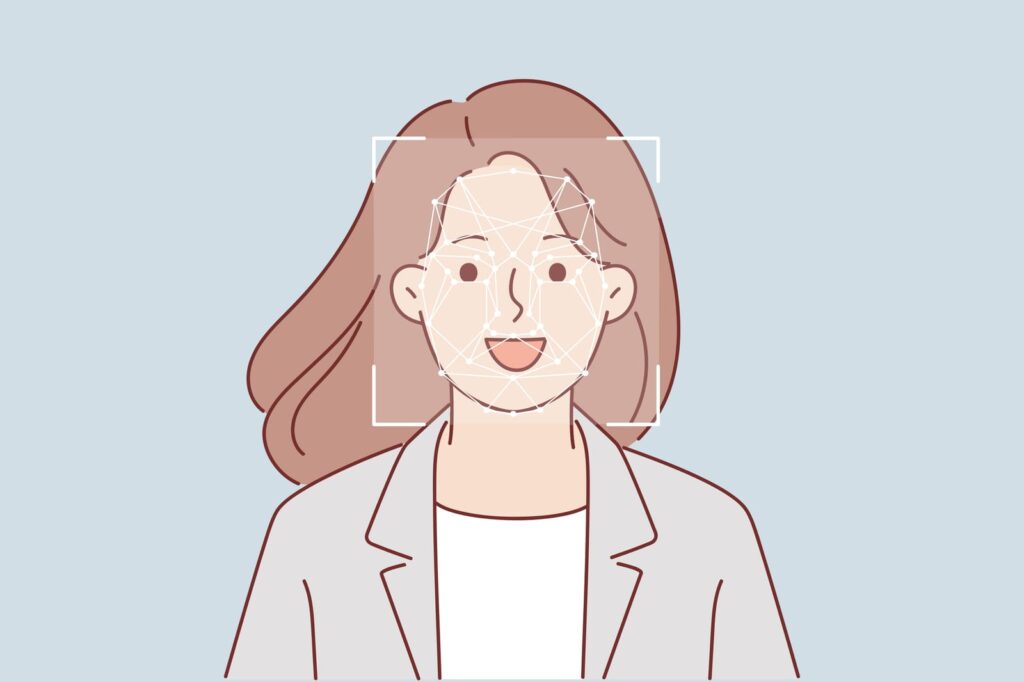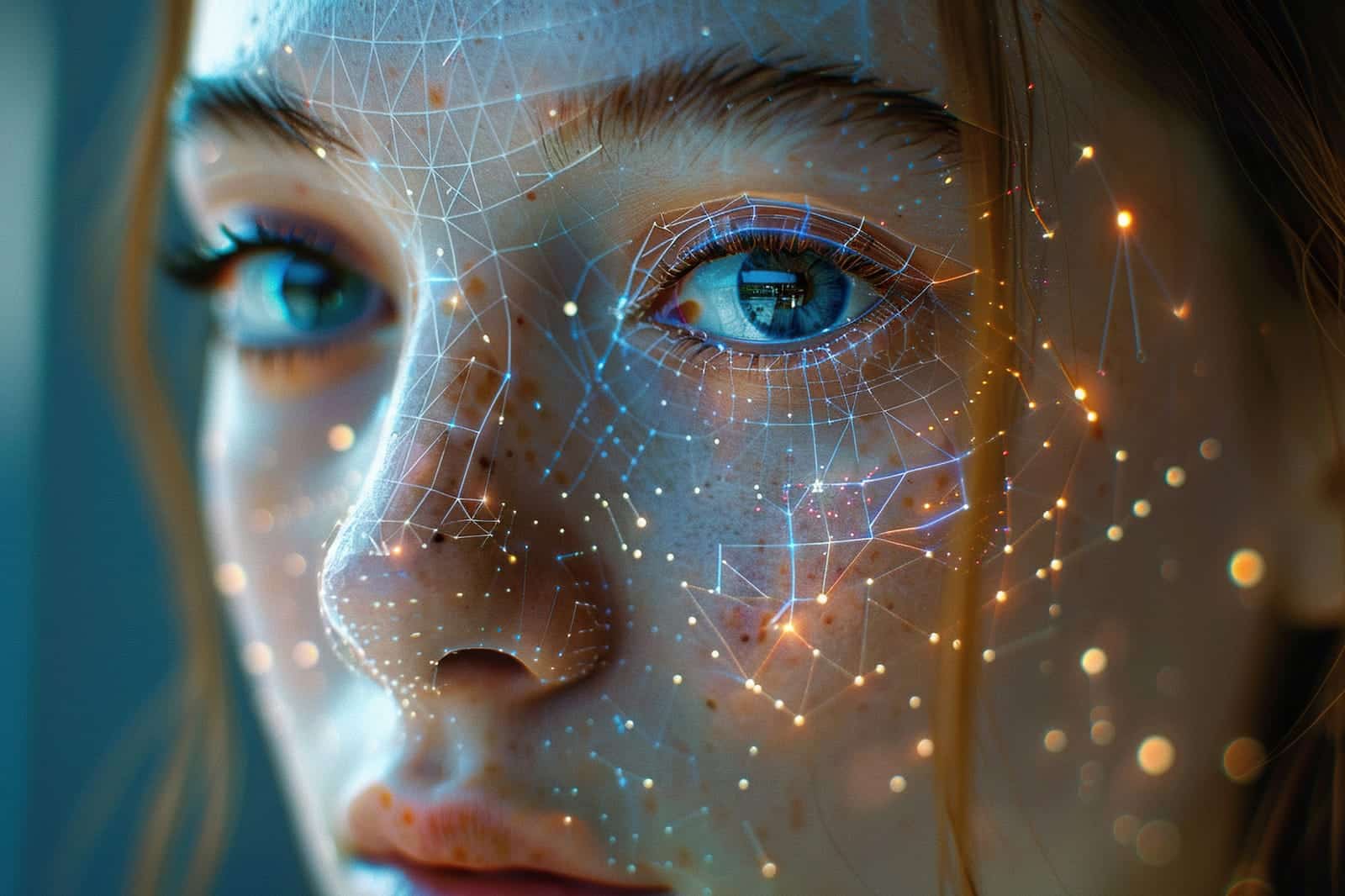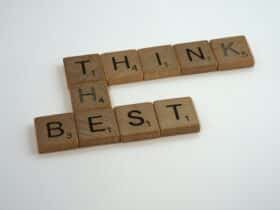Facial recognition technology goes back to the 1960s. A few years after its debut, law enforcement agencies developed their own facial recognition technology. The initial systems were relatively simple, but the advancement in technology led to the development of sophisticated facial recognition software.
The biggest advancement in facial recognition happened in 2010. Developers designed computers with enough capacity to contain facial recognition as a standard feature.
With the popularity of facial recognition technology, some concerns regarding its accuracy started raising eyebrows. Recently, this problem has been improved by far as accuracy has been increased, and the margin of error lowered. Moreover, the accuracy is much higher when the faces are clearer.
What Type of Technology Is Facial Recognition?
Facial recognition technology falls under the category of biometric security tech. It is a way of confirming an individual’s identity in photos or videos. It also identifies people in real-time.
This is possible because of the advancement in technology. Initially, law enforcement and security agencies were major users of this technology. But with each passing day, it slowly made its way into our daily lives. The most common example of this is the unlocking of phones using face recognition.
The process of facial recognition has two types called Digital Onboarding and Authentication.
Digital Onboarding is the type where a recognition device detects a face. It then registers it into a system and attaches an identity to it. This way, the face is recorded into the system for future purposes.
Authentication is the type of facial recognition technology that identifies a match. When face recognition is used, it checks the data from the camera with already existing information. The identity of the individual is already recorded in the system. If the face matches the pre-recorded image, the system grants access to the individual.
How Does Face Recognition Work?

Facial recognition technologies generally vary, but the difference is relatively insignificant. Most technologies have basic functions, which can be broken down into the following steps:
Face Detection
In the first step, the camera placed in the device detects an image of the person. The person can be in a public space or private. The image can be captured either from the front or the side of the face.
Analysis
In the second step, the software captures the image of the person and analyzes it. The analysis is done in 2D rather than 3D. This is because most images in the database exist in 2D. The face recognition software studies some features of your face to identify a match.
These features include the shape of your cheeks, the distance between your eyes, the distance between your forehead and chin, the shape of your lips, ears, and nose, and chin. The software specifically analyzes these features. This is because these are key features that distinguish your face.
Conversion of the Image into Data
The software analyzes the image and then converts it into a piece of digital information. This information is based on the person’s facial features. Your features are converted into a digital formula called a “faceprint.” The faceprint has its unique code of numbers. This code is different for every person, just like your fingerprints.
Looking for a Match
The software then matches the faceprint against the millions of faces present in the database. If the faceprint matches an image in the database, it displays the result.
Facial recognition is the most common due to its convenience.
Uses of Facial Recognition Technology

Facial recognition is not only limited to certain organizations for biometric identification. It has become an important part of our daily lives. Some of these include:
Law Enforcement
Law enforcement agencies depend on facial recognition. Police departments all around the world take pictures of the arrested people. The police then run these photos into databases to find the match. If the arrested person has a previous criminal record, it will pop up on the screen along with the ID of the criminal.
Missing Persons’ Search
Facial recognition plays an essential role in finding missing people. The police add a picture of the person to the database when the family files a missing person’s report. This is helpful in cases of human smuggling or kidnappings. The airports, general stores, or streets cameras inform the police as soon as they recognize the face.
Banking
Face recognition has also improved banking. Instead of filling the passwords every time, customers can now confirm and authorize matters by face recognition. This is also fruitful because it has eliminated the chances of hackers stealing your information.
In case a hacker steals your photo from the database, a backup technique called “liveless” can save your information. This detection technique helps prevent imitation. It also determines whether the biometric source is a live human being or a fake representation. Face recognition can also eliminate the need for debit cards.
Healthcare
Hospitals are using facial recognition techniques to improve patient care. It is currently under experimentation for accessing records, automatically registering patients, detecting pain and emotions in patients, and identifying specific genetic disorders.
As facial recognition becomes a common tool, it becomes less and less expensive. This has encouraged the healthcare sector to adopt it at a rapid pace.
AiCure is a software developing company based in New York. It has designed a software that checks whether the patients are taking their medicines as per prescription.
Airports
Airports around the world are using facial recognition technology. Travelers and tourists are slowly shifting towards biometric passports. This has eliminated the need to stand in long lines. With facial recognition, travelers quickly walk through the e-passport control and reach the gates faster.
Is Face Recognition Augmented Reality?

Augmented Reality is one of the components of Extended Reality (XR). XR uses sound overlaying technology and digital graphics to create an environment. This environment is an immersive experience that is similar to your real-life surroundings.
AR deals with digital tools like animations, images, and texts to create a virtual environment. You can experience this environment through AR screens, smartphones, and tablets.
The simplest example to understand Augmented Reality is Snapchat. The filters of the app use recognition software to analyze your facial features. It then puts objects on your face, such as tattoos, jewelry, hats, makeup, etc. This explains that facial recognition is a component of AR.
With smartphones rapidly taking over technological and telecommunications devices, AR technology has also taken its place in smartphones. This has been one of the most incredible advancements so far.
Just by a click and holding a phone to our faces, we can travel into a dreamlike world. We can also create and experience fascinating and aesthetic views. This is possible because of the fusion of facial recognition software and AR projects. We can create an entirely different world and decide how we appear in it.
Before learning about AR facial recognition, you need to know the difference between biometric facial recognition and AR facial recognition.
Biometric facial recognition only recognizes the face and analyzes the features. After thorough scanning, it confirms the identity of an individual. On the other hand, AR facial recognition uses a camera that detects the presence of a face.
Then it puts AR filters on the face, such as effects and filters. It can also detect changes in emotions such as a smile, frown, raised eyebrows, etc.
How Does AR Face Tracking Work?
The tracking of the human face is a fusion of some concepts such as:
Anchors
When a camera recognizes an object, it places an anchor on it. This anchor records the exact placement of the object. Now when the camera moves, the anchored objects move along with it. The AR keeps track of the anchored objects so that they can be updated with every move.
Entities
Entities are the objects that we can place on an anchor. You can place anything on the anchors. Once you put an object on the anchor, the AR tracking system keeps a check on it. AR also maintains its position in the virtual world, the same as the real world.
In addition to anchors and entities, face tracking also constitutes a group of numbers called coefficients. These coefficients track the movement of your facial features such as eyes, lips, jaws, eyebrows. The 3D modeling is a product of these facial geometries.
Keeping the objects exactly where you left them in AR tracking is not as easy as it looks. As you keep moving around, the objects keep getting out of the camera’s view. This is because keeping things in the same place requires some computer-based calculations. These calculations are costly. So, most developers find shortcuts to balance the accuracy between real-time and virtual frames.
Therefore, the objects shift from their actual position at times. The anchor, however, stays in the place. This phenomenon is called drift. The more resources a company has, the more it can remove the drift.
Since mobile companies have fewer resources, mobile devices have anchors and objects that tend to be less accurate.
Uses of AR Facial Tracking
The most common application of AR face tracking is Snapchat and Instagram filters. You can not only put objects on your face but change your appearance too. Snapchat and Instagram filters are becoming very famous as of late. Many people use these filters to enhance their features.
Another example is the L’Oreal makeup app. It lets the user try on different makeup looks. This makes it easy for you to see which makeup looks suit your face. Women have been pulled to this app recently.
The AR face-tracking technology is much more than software that enhances features. Some applications such as MS Teams and Zoom have incorporated AR face tracking and filters in the apps. These filters can even be applied to video conference calls. These filters also change your background to make it look like you are in unusual locations.
In addition, gaming industries also use AR Filter via face tracking. This allows the users to put on AR hats, masks, avatars in the game.
Another advantage of AR is anonymity. It allows gamers and social media influencers to hide their personalities by creating fake personas.
AR facial recognition is also making its way into dating websites. People can now chat with each other without revealing their identities first.
Most importantly, AR face recognition has brought new horizons to the healthcare industry. Healthcare providers can meet patients remotely, especially in times of a pandemic. Moreover, doctors can detect changes in your facial features. They do so by analyzing eyes (puffiness, swelling), swollen lymph nodes, pink eye, jaundice, and the list goes on.
Therapists can use face recognition technology to determine whether the patient is lying, nervous, anxious, distressed, agitated, etc. This feature can help build a much better and stress-free environment.
Another application of AR facial recognition is driverless cars. The users wear AR headsets and glasses and can get information about the routes and traffic situations. The user then feeds this information to AI cars.
Conclusion
Face tracking is not a new concept. It has been in the market for some time now. However, the incorporation of AR into face tracking is introducing innovative ideas.
Although this technology is still developing, it shows potential for revolutionizing our lives. However, as technology improves our lives, it also comes with disadvantages. One of the most significant disadvantages is the breach of privacy.
The companies can vividly recreate your life as the cameras continuously record your movements, audio, video, and surroundings. This gives them access to your private life without your knowledge. However, we cannot resort to a conventional lifestyle because of these concerns.
Therefore, we need robust policies and strict authority to keep the technologies in check. The only way to move forward with time is to accept the change and mold your lives around it.


















